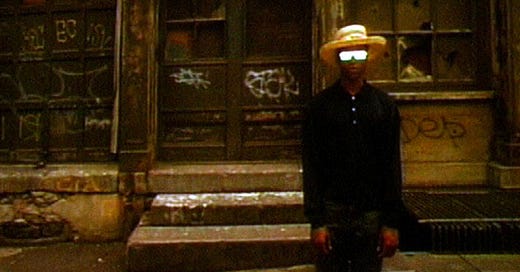Hauntology Now! is the Substack of interdisciplinary artist, designer, musician, academic writer, and cultural critic J. Simpson, where he writes about all things hauntological, atemporal, philosophical, as well as sharing thoughts, reflections, and musings on music, movies, books, and life.
The Last Angel Of History, dir. John Akomfrah (1996)
Today’s the last day of Black History Month. In honor of the occasion, I’ve been researching all manner of Black history this month, from Black horror to Black cinema to Black art to Black speculative fiction, of which Afrofuturism is one of the more prominent strands.
As part of this research, i re-visited Marc Fisher’s excellent essay The Metaphysics of Crackle: Afrofuturism and Hauntology, published in Dancecult in 2013, where he discusses presence, absence, dub, rockism, privilege, and “authenticity,” digging into the convoluted politics of presence during the digital age, the revenant quality of recorded music, particularly the human voice, delving in its thorny, troublesome relationship to the written word that have shadowed most of Western civilization. Instead, Fisher praises dub as a “a breakthrough because the seam of its recording was turned inside out for us to hear and exult in; when we had been used to the ‘re’ of recording being repressed, recessed, as though it really were just a re-presentation of something that already existed in its own right,” citing critic Ian Penman.
In certain regards, dub’s open acknowledgement of its status as a recording. Perhaps conversations around performativity weren’t as prevalent or as nuanced as they are today, but it seems highly unlikely Mick Jagger’s frontman antics aren’t as rehearsed as any Pop diva or duck-lipped influencer.
Fisher’s essay on Afrofuturism is important, lest hauntology simply become more nostalgia. When hauntology first entered the cultural conversation on a more mainstream scale, it largely focused on the uncanny wyrdness of the U.K. in the ‘60s and ‘70s. It’s far too easy to simply make retrodelic art referencing Dr. Who and vintage Penguin paperbacks. If anything, hauntology was critiquing the retrophilia of the early 21st Century as much as it was celebrating under-appreciated culture. The seams allow the phantoms and revenants to bleed forth like miracles or ancestral curses.
As part of my research, I put together an Afrofuturism Spotify playlist, featuring experimental music, sound art, and thoughtful, adventurous Black music. Classic hauntological music from the likes of Burial and Tricky meet contemporary artists like KMRU, Actress, clipping., and Pink Siifu, as well as vintage field recordings from Black culture throughout history.
You can also listen to Mark Fisher’s Afrofuturism mix for Pontone, summoning an ice floe of crackles and crumbling textures from artists like Philip Jeck, William Basinski, The Caretaker, Moon Wiring Club, Mordant Music, and Pole.
For even more incredible Black art, check out my first article on photography for No Apologies Magazine, Through Their Own Lens: 21 Black Photographers You Need To See, where I write about art photographers like Prince Gyasi, Cam Hicks, Dana Scruggs, Carrie Mae Weems, and Marilyn Nance, among many others.
I’m going to be doing a lot more writing about visual art and photography over there, so make sure to watch that space!



